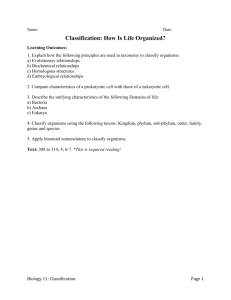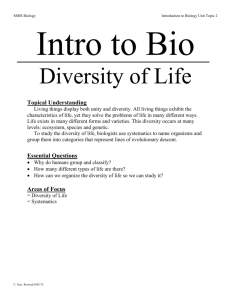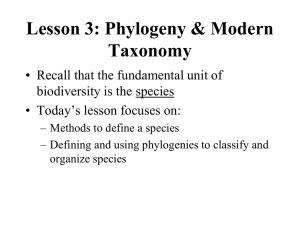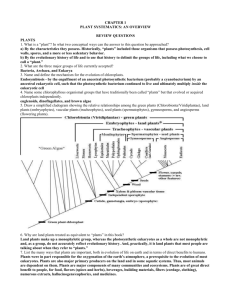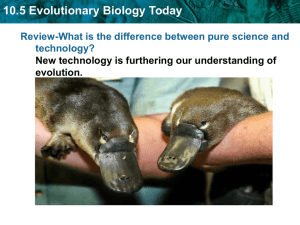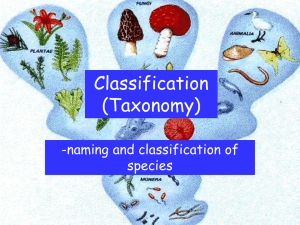File - Frykberg Science
advertisement
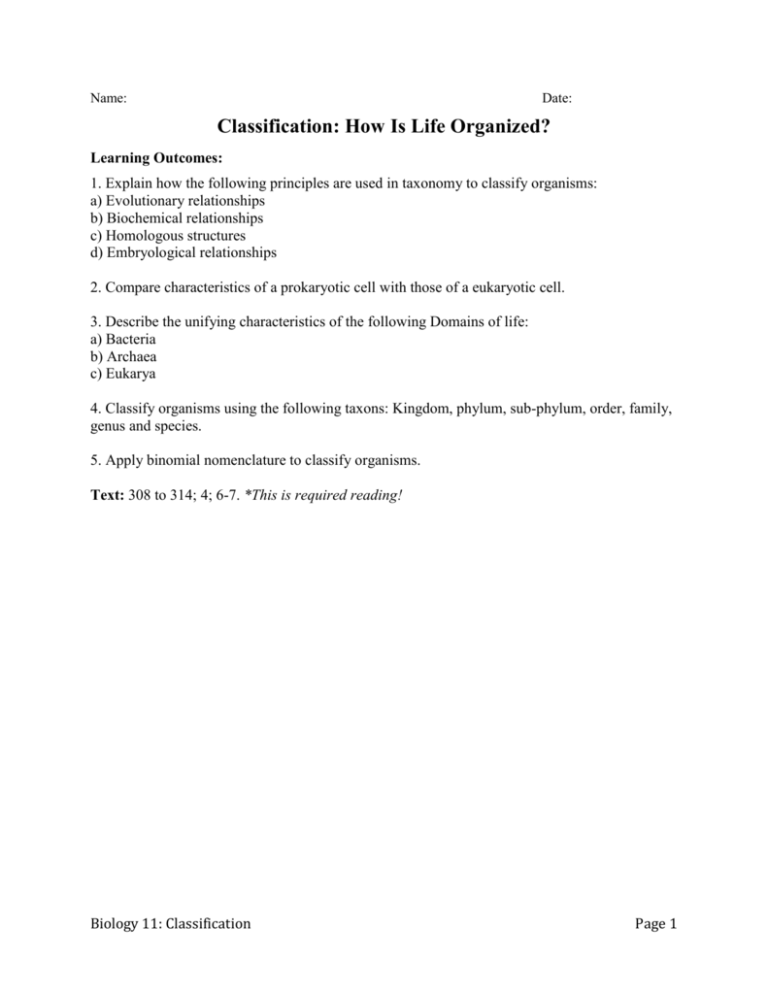
Name: Date: Classification: How Is Life Organized? Learning Outcomes: 1. Explain how the following principles are used in taxonomy to classify organisms: a) Evolutionary relationships b) Biochemical relationships c) Homologous structures d) Embryological relationships 2. Compare characteristics of a prokaryotic cell with those of a eukaryotic cell. 3. Describe the unifying characteristics of the following Domains of life: a) Bacteria b) Archaea c) Eukarya 4. Classify organisms using the following taxons: Kingdom, phylum, sub-phylum, order, family, genus and species. 5. Apply binomial nomenclature to classify organisms. Text: 308 to 314; 4; 6-7. *This is required reading! Biology 11: Classification Page 1 Cells as a Basis for Classification At a very basic level, organisms can be divided based on whether they have cells or not. This will determine whether they are classified as “living” or “non-living”. -Viruses are not considered to be non-living as they are not made up of a cell(s). Viruses are just protein capsules containing genetic material (RNA or DNA). -Cells are only found in living organisms and they represent the lowest level of structure capable of performing all the activities required for life (e.g. Able to respond to their environment, metabolism) Living organisms are divided into two large groups depending on what type of cell(s) they have. Name and describe the differences between the two: a) ___________________________________________________________________________ ______________________________________________________________________________ ______________________________________________________________________________ b) ___________________________________________________________________________ ______________________________________________________________________________ ______________________________________________________________________________ Biology 11: Classification Page 2 Label the main structures highlighting the simularities and differences between these cell types. Phylogeny and the Tree of Life Phylogenies Reflect Evolutionary Histories A phylogeny is the evolutionary history of a species or group of species. What type of evidence can be used to discover a species phylogeny? ______________________________________________________________________________ ______________________________________________________________________________ ______________________________________________________________________________ ______________________________________________________________________________ ______________________________________________________________________________ Biology 11: Classification Page 3 Systematics Connects Classification with Phylogeny Systematics is the branch of biology that classifies organisms and determines their evolutionary relationships. This is also called “taxonomy” Systematics groups organisms into categories which range from very inclusive to very specific. Examine the diagram of a house cat’s classification: a) Which category (taxon) is most inclusive? _____________________________________________________________ b) Which taxon is least inclusive? _____________________________________________________________ c) What do each taxon represent? ___________________________________________________ ___________________________________________________ d) What is represented by the scientific name Felis catus? ___________________________________________________ e) What is any easy way to remember the correct order of the taxonomic categories? ___________________________________________________ ___________________________________________________ Phylogeny and classification are combined through the creation of a phylogenetic tree. Again, this is hierarchical and becomes more inclusive as you move through it. Phylogenetic Trees Reconstructing a species’ evolutionary history involves sorting homologous from analogous features and then infering phylogeny. Below are the steps involved in this process: 1. Cladistics: -Common ancestry is used to group organisms into clades (ancestral species and its descendents, monophyletic). -Shared characteristic can be grouped two ways: a) Shared ancestral characteristic ______________________________________________________________________________ ______________________________________________________________________________ Biology 11: Classification Page 4 ______________________________________________________________________________ ______________________________________________________________________________ b) Shared derived character ______________________________________________________________________________ ______________________________________________________________________________ ______________________________________________________________________________ ______________________________________________________________________________ 2. Creating Phylogenies Using Shared Characteristics -Shared characters can be organized into a Character Table that allows for a Phylogenetic Tree to be created. Two clades are used in this process: a) Outgroup: ___________________________________________________________________ ______________________________________________________________________________ b) Ingroup: ____________________________________________________________________ ______________________________________________________________________________ Biology 11: Classification Page 5 -Phylogenetic trees are organized based on the idea of parsimony, that the simplest explanation for observed phenomena are the best. 3. Molecular Systematics and Phylogenetic Trees -DNA and other molecular evidence can be used to trace phylogeny (remember the Molecular Connection assignment). -DNA evidence is valuable as: ________________________________ ________________________________ ________________________________ ________________________________ ________________________________ ________________________________ ________________________________ Find 2 more phylogenetic trees in your textbook! Pages? ________________________________________________Biology 11: Classification Page 6 Constructing the Tree of Life Domain is the largest classification taxa. What is evidence is used to determine to which domain organisms belong? ______________________________________________________________________________ Below is an image of our current understanding of the phylogeny of the three domains of life. Next to each of the images below, name and briefly describe the domain it represents. Text: 6-7. ________________________________________________________ ________________________________________________________ ________________________________________________________ ________________________________________________________ ________________________________________________________ Biology 11: Classification Page 7 ___________________________________________________ ___________________________________________________ ___________________________________________________ ___________________________________________________ ___________________________________________________ ____________________________________________________ _____________________________________________________ _____________________________________________________ _____________________________________________________ _____________________________________________________ _____________________________________________________ _____________________________________________________ _____________________________________________________ http://www.youtube.com/watch?v=BQ1JaYxBH40&feature=fvw Take your own notes to explain how the kingdoms of the Domain Eukarya are divided: Kingdom Uni/Multi Cellular? Biology 11: Classification Nutrition Other Info Page 8 Kingdom Uni/Multi Cellular? Nutrition Other Info Kingdom Uni/Multi Cellular? Nutrition Other Info Kingdom Uni/Multi Cellular? Nutrition Other Info Biology 11: Classification Page 9 In the table below list the classification categories from the one with the largest number of individuals to the smallest number and develop your own pneumonic to remember the order. Fill in the classification of a striped skunk, cat and a wolf. Fig. 15.15B will help you. Categories Striped Skunk Wolf Domestic cat Domain Kingdom Biology 11: Classification Page 10
